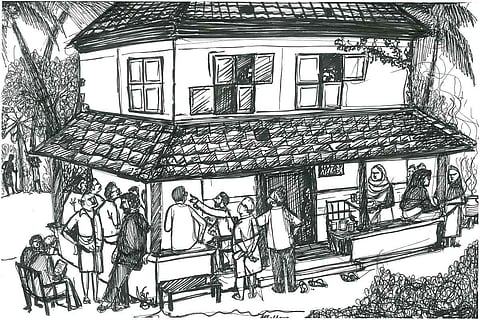

On a hot summer day in 1965, MV Devan—later to become one of Kerala’s leading cultural activists, an orator and artist—made a trip from Madras to Calicut with a poem that he had penned. At the Imperial Hotel, he read it out to a small gathering of friends. None of the participants recollected the poem as being particularly good, and, at the time, they did not hold back from sharing their views. But such was the nature of engaged discussions that the friends decided to make this gathering a weekly event.
For the next five years, a group of poets, writers and cultural figures gathered every week to discuss poetry, arts, culture and literature. There was only one rule to the conversations: informality. It was also decided that participants would take turns hosting the gathering, usually on the verandas of their homes. To reflect the informality and unstructured nature of these conversations, the group also decided to name their gatherings kōlāya, the Malayalam word for veranda.
The regular attendees of Kōlāya conversations of the mid-1960s, included thinkers, artists, writers and poets. Many of them would go on to become notable names in their fields. Apart from Devan, the renowned historian MGS Narayanan, writer NP Mohammed, poets Akkitham and NN Kakkad, and artist Namboothiri were all regulars at the gatherings. There would be no pre-set agenda; free-flowing conversations “were the life of Kōlāya”. Some of the regulars would recall in their compilation of conversations many years later: “No opinions were hidden…No participant came to Kōlāya prepared. This would have been impossible. It would be their first introduction to the writing being discussed”. On days when discussions were uninspired and monotonous, participants would turn to gossip and shooting-the-breeze sessions.
Even while the gatherings carried the informality of a friendly conversation, the content of these discussions reflected rich details, contemplation, critique, and cosmopolitanism. On days when the participants didn’t have any original works to present to the gathering, contemporary and classical Malayalam poetry, literary criticism, and, sometimes, political issues were discussed and debated. During one gathering, PM Narayanan recollects Akkitham composing an on-the-spot poem about Morarji Desai’s gold regulation laws. On some days, the group turned to Western literature, poetry and drama. The Preface to their collected works published in 1971 notes: “Jean Giraudoux… Pirandello, Spanish, Italian, French poetry; we were introduced to new imaginations and worldviews through these. They have helped strengthen our sustained imagination about theatre and pure poetry”.
Once the gatherings started becoming day-long affairs at the homes, they often transcended the public-private boundaries, and the families of participants got involved. MGS Narayanan notes in Kōlāyacharchakal (Kōlāya Discussions, 2010) published by Current Books:
Once the literary gatherings of wayside tramps moved into the verandas of homes, families became participants too. Sometimes, there would be parallel gatherings of family members. While the Kōlāya was in session outside, the kitchen would be busy with preparations.
Hafeez Muhammad’s note on the importance of Kōlāyas in Kozhikode’s cultural and literary history gives us a glimpse of what these “preparations in the kitchen” entailed for the women in the households. Hafeez’s father, NP Muhammad was a famous writer and an active member of Kōlāya. As a young boy, Hafeez remembers the excitement at home on one Sunday morning:
I went to the kitchen. Mother and aunts were busy with some preparations. I asked my mother: “what is going to happen here?”
“Friends of your father are visiting”. It was (my) aunt who answered.
“Why?”
“Why? To speak about this and that and create a ruckus, why else?”, aunt replied.
“Is that why you are preparing?”
“Don’t those creating the ruckus have to be fed? And your father is very particular about what he wants.”
Within most archived and oral histories of Kōlāya, women only appear fleetingly as hosts or sometimes as a deviation from the otherwise “serious” discussions on art and literature, like an incident Namboothiri recollects in Kōlāyacharchakal:
A discussion on art ensued during a Kōlāya at Venu’s house. I observed that art can be made in any medium. Venu’s wife quickly asked: “can it be on sarees?”
“Yes”
[She] purchased two-three sarees and handed them to me. I painted on them and returned them. She wore one of them for the next Kōlāya. Venu remarked: “My wife’s first fashion parade.”
Kōlāya’s strength was its informality. But this would also become its weakness. Interest began to dwindle when some participants began to feel that the group were being overly critical merely for the sake of it. Some members moved away after being transferred to other cities for work. Original contributions at the gathering began to reduce in number. People started finding it difficult to host others at home for an entire day, and some members decided to move the gathering to hotels. This, the regulars at the gathering suggest in their book, was the beginning of the end for Kōlāya. Yet, the history of Kōlāya is a history of conversations; of thresholds and liminal spaces that have been denied their rightful place in most accounts of modernity.
Such koottaymas—gatherings of informal nature—have been a crucial yet under-explored part of Kerala’s modernity, thanks to a fixation on the visible in the febrile space of public political discussion that leads us to questions of decline and fall, of the end of particular imaginations, and assertions that some ideas, having become part of a public vocabulary, no longer are part of engaged discourse anymore. More must be done to archive these, and such initiatives need us to think less with the idea of the margins than the interstices and liminal spaces within a putative public sphere.
S Harikrishnan is an Assistant Professor at Dublin City University and a founding editor of Ala.
Dilip Menon is a historian and a professor at the University of Witwatersrand. He is also the Director of Centre for Indian Studies in Africa (CISA)